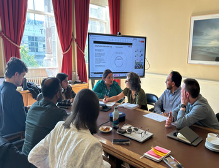‘May you live in interesting times,’ an English expression whose origin is commonly (and very probably wrongly) understood to be a Chinese curse, seems particularly relevant right now. It’s definitely an interesting time in which to live. Democracies hacked. Public health in peril. Economies under pressure. And amongst all these challenges, we have to keep somehow working, keep producing output, keep helping each other to move forward. And we have to do this through channels that lack all of the tools that evolution has given us to understand each other: body language, proximity, facial gestures. Nothing like a blip in bandwidth freezing your zoom partner in mid gurn to make you feel like everything you’re saying is unfounded rubbish.
To make sure we survive this (no pun intended, it’s likely some of us will have had dark moments in the night wondering whether all those movies had it right and we’re about to see the End of Days), we will need to get creative not only about how we work with each other but about what we consider ‘the workplace’. Indeed, we need to feel that the people we work with care about us. That our employer cares about who we are, and not just our work duties. Can we remember this being an acknowledged need before Covid? If you’re an HR leader, do you remember this ever being more critical than right now, at a time when the very practice and logistics of work is so challenged? This duty of care is newly relevant and a real challenge to the logistics of care, the logistics of work.
Limeade is an employee experience company with a creative solution. They were lucky (as it were) with their data collection efforts, in that they launched their 2020 Employee Care Report survey on March 5, just days before stay-at-home orders were declared across the United States and around the globe. The results showed that employers were mostly failing on employee care. In their follow-up, they surveyed 1,000 employees (500 in manager roles and 500 in non-managerial positions) at companies with 500 employees or more. The survey measured burnout, well-being, and perceptions of employee care during the first few months of the pandemic. What they found is interesting on many levels.
We need to feel that the people we work with care about us
Often, managers feel that they have everything under control or are least equipped to deal with the significant burden of leading their teams. Just as often, however, their teams feel differently. In Limeade’s report, only 55% of non-managerial workers felt their employers exercised genuine care regarding their well-being, whereas 77% of managers felt this was the case. More significantly, although 71% of managers reported that in one-on-one meetings with their direct reports, the was a real focus on well-being, only 33% of non-managerial workers said the same. This points at a real discrepancy between worker perception and that of their managers and leaders and highlights more clearly than has been seen before why leaders play such a pivotal role in organizations and why their behaviour has a significant impact on the work, performance, and well-being of their employees.
Limeade’s report also points to the fact that managers are again feeling the pain. It’s clear that they are working longer hours since the pandemic started and that expectations are so heightened that they are expected to work even when they are sick. Leaders must address these gaps, in both perception and the actual delivery of well-being strategy, to properly take care of their organizations.
Spotting the burnout
In Limeade’s report, 72% of employees reporting feeling burned out, which is a substantial increase from their 2020 Employee Care Report, where only 42% of respondents said the same. Keeping in mind that 42% burnout is significant already, this jump is indicative of the pandemic’s toll. Although some managers understand that their own behaviour and strategy directly affect their employees’ chances of experiencing burnout, they have never faced circumstances where burnout is so high.
As Limeade points out, without adequate training on spotting the signs of burnout, managers can hardly be expected to help; it’s the organization’s responsibility to ensure that appropriate training is provided company-wide.
Interestingly, the report also highlighted differences between male and female managers, with female managers reporting lower job security levels and overall well-being than their male counterparts. This difference has been investigated elsewhere: in a study surveying working conditions with a sample of 5,496 men and 2,779 women aimed at analyzing whether any differences exist between genders on how individuals perceive and suffer high levels of job stress, researchers found that job stress is suffered differently in men and women. With men, their results showed that only one dimension of the job demands was significant (quantitative demands), whose effect on job stress is “weakened slightly by the direct effects of control and support,” meaning the amount of job autonomy and control and individual has. In contrast, emotional and intellectual dimensions (qualitative demands) were also statistically significant to them, not just power and logistic support. Social support, which men benefit from to a lesser extent than women as they are taught from an early age to act tough and be ‘independent’, has a more significant role in lowering levels of job stress in women than in men.
The great gender remote work divide
The differences in shared experiences between male and female managers during the pandemic are staggering. Female managers reported lower levels of job security and well-being in comparison to their male counterparts.
While sixty percent of male managers said they felt “extremely comfortable” asking for time off to focus on their well-being, only 25% of female managers did. If we consider that only 11% of women reported “extremely positive” well-being during the pandemic in contrast to 42% of men, this statistic alone points to a drastically different experience across the gender divide or not only the experience of work, but of life under the pandemic.
We need to re-examine gender stereotypes at work and home
Not only do women feel there is less support for them at work and have to deal with the well-known disparities in caregiving and family support that were there before the pandemic, but now they have children whose schooling is in peril, and face having to provide extra didactic support while working from home.
This, at a time when everyone is staying put in their jobs and not rocking the boat as vast economic uncertainty looms over all of us. At a time when corporate employers are using the crisis to make people work harder and calling for ‘WWII spirit’ and ‘all hands on deck’ attitude, as though 18 hour days will help us any more than they ever did (burnout helps no one).
As Jeanne Meister wrote in her excellent piece on the workplace during pandemic times, this is the time to find new ways to support our employees. There has never, in recent memory, been a more meaningful opportunity to address workplace inequalities. To examine why we pretend that men pretending to be ‘ok’ is ok at all. To re-examine gender stereotypes at work and home. To redesign our well-being programs and create new HR practices.
It’s a profound opportunity to redesign not just workplace culture, but culture overall.
This article was originally posted on the Forbes website.





